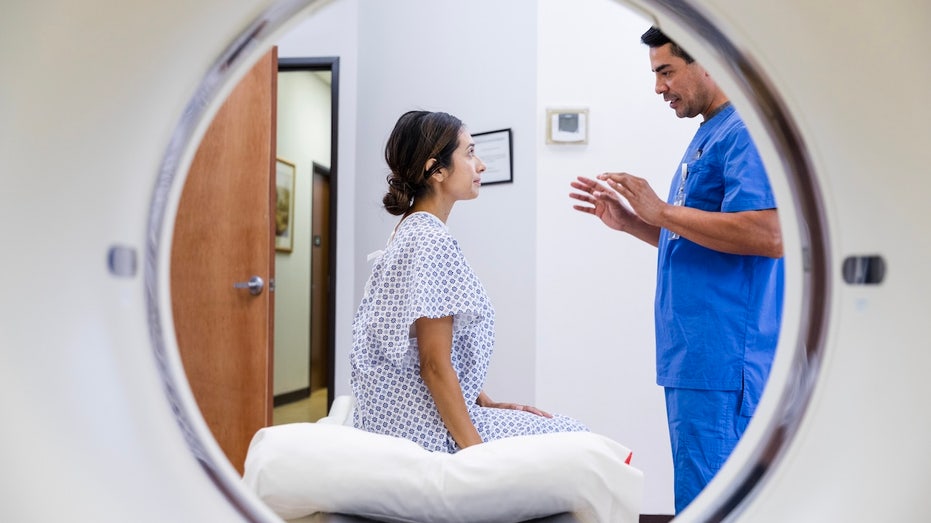
CT scans, or CAT scans, are widely used to get internal images of the body and diagnose dangerous medical conditions — but they could pose a hidden risk. Doctors discuss.
CT scans, or CAT scans, are widely used to get internal images of the body and diagnose dangerous medical conditions — but they could pose a hidden risk.
A new study from the University of California – San Francisco found that CT (computed tomography) scans could be responsible for 5% of all cancer diagnoses each year, according to a press release.
“While some uncertainty exists, it doesn’t significantly affect the core conclusion: A small but meaningful percentage of cancers are linked to CT scans, and this number can be reduced,” first author Rebecca Smith-Bindman, MD, a UCSF radiologist and professor, told Fox News Digital.
5 CANCER TYPES WHERE SCREENINGS SAVE THE MOST LIVES
The researchers’ estimates show that the ionizing radiation exposure from CT scans is comparable to other significant risk factors, such as alcohol consumption and excess body weight.
To predict how many future cancers could result from current CT scans, the researchers updated a previous analysis of 2023 data on scan volumes, scan types and radiation doses, according to Smith-Bindman, MD.
“We used a well-validated model to estimate cancer risk and conducted sensitivity analyses to confirm the robustness of our findings,” she said.
“This is a modeling study, meaning our conclusions depend on the accuracy of the data used.”
COMMON CANCER TYPE COULD BE DETECTED WITH NEW BLOOD TEST
Based on the review, the researchers estimate that approximately 103,000 future cancers will be caused by CT scans performed in 2023 in the U.S., with the highest number of cases affecting adults aged 50 to 69.
Individual cancer risk is highest for babies and children, with babies under 1 year old 10 times more likely to develop the disease compared to others in the study.
Adults, however, account for the majority of scans, which drives the overall cancer burden, Smith-Bindman noted.
The most common cancer types resulting from CT radiation, according to the study, include lung cancer, colon cancer, leukemia and breast cancer.
The study, which was published on April 14 in JAMA Internal Medicine, received funding from the National Institutes of Health.
“In many cases, CT is the most appropriate test for achieving rapid and accurate diagnoses,” Smith-Bindman told Fox News Digital.
“However, the use of CT continues to rise, including a concerning increase in imaging that is performed without a justified medical reason — often referred to as ‘low-value scanning.’”
CANCER SCREENINGS: HERE ARE 5 TYPES AND CRITICAL INFORMATION TO KNOW ABOUT EACH
Based on the findings, the researchers recommend avoiding unnecessary CT scans to avoid potential harms.
Another risk-reducing approach is to lower the radiation dose per scan.
“CT doses are sometimes higher than necessary, so patients are encouraged to ask their healthcare providers or technologists to use the lowest possible dose for their scan,” Smith-Bindman advised.
Ultimately, the researcher said, patients should have informed conversations with their healthcare providers about the necessity of a CT scan and whether alternative imaging options — like ultrasound or MRI — might be more appropriate.
“If CT is clearly indicated, the benefits far outweigh the risks,” she said. “But if not, it’s best to avoid the scan altogether.”
Dr. Nicole Saphier, board-certified radiologist and Fox News medical contributor, was not involved in the study but commented on the risks and benefits of CT scans.
“I have long advocated for the judicious use of medical imaging, often citing that less can be more when it comes to good patient care,” she told Fox News Digital.
IMAGE
“The recent study linking the ionizing radiation from CT scans to an increased risk of cancer underscores what many in the medical community have understood for years: while imaging is a powerful diagnostic tool, it is not without risk.”
Saphier said the study may even underestimate the total number of cancers attributable to medical imaging.
“Many cases of medical intervention-induced cancers may go unrecognized due to long latency periods, the complex interplay of contributing factors and the fact they omitted radiation from image-guided procedures, x-rays and other forms of medical radiation from this study,” she noted.
CLICK HERE TO SIGN UP FOR OUR HEALTH NEWSLETTER
“As imaging use and medical interventions continue to rise — especially in younger populations — the cumulative radiation exposure over a lifetime becomes an increasingly important consideration.”
That said, Saphier went on, CT scans and other medical imaging modalities — which are “fast and cheap” — save lives every day.
“The key is balance. Physicians must remain vigilant in weighing the benefits against the risks, and should always explore alternative modalities when appropriate, such as ultrasound or MRI, which do not use ionizing radiation.”
Informed decision-making is essential for both clinicians and patients, according to the doctor.
For more Health articles, visit www.foxnews.com/health
“We must continue to refine our protocols, limit unnecessary imaging and ensure we are using the lowest possible doses without compromising diagnostic quality,” Saphier concluded.
“This is not a call to avoid CT scans — it is a call to use them wisely.”



